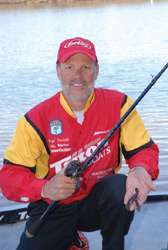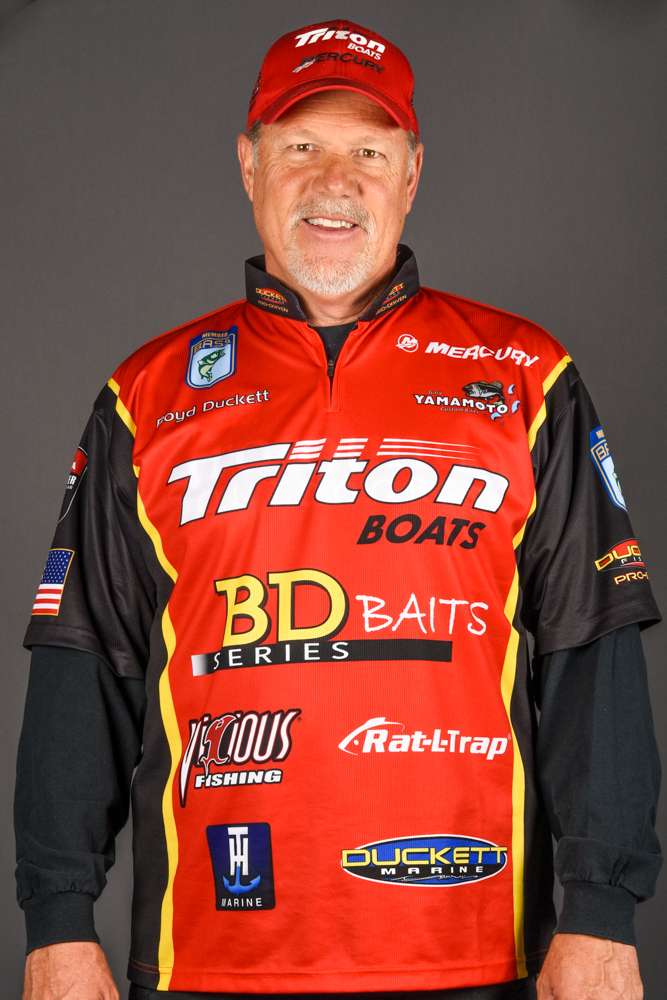
Being a Southern guy and seeing as how I won the Bassmaster Classic flipping a Berkley PowerBait Chigger Craw, most people probably don't associate me with shaky head jigs. For a lot of people, fishing with a shaky head means cooler water, smallmouth fishing, things like that. Sometimes, misconceptions abound.
In fact, I've done a lot of fishing with a shaky head, in various parts of the country for all species of bass. I can remember learning to use one a long time ago catching spotted bass on Georgia's Lake Lanier. Last year, when I qualified for the Classic, I did it through the Bassmaster Northern Opens where there were several times that a shaky head came into play. The common denominator between the times where I used a shaky head wasn't the fish species I was after or the part of the country that I was fishing. Instead it was the behavior of the fish: once they shut down, I slowed down and went after them with a worm on a shaky head.
One thing's for sure: fishing a shaky head jig is not a power technique. It's for targeting inactive fish or for fishing during colder weather. A lot of times, anglers get down on fishing these because it's not something that you just go out and fan cast and reel in like a crankbait. It's a slow-down-and-cover-an-area type of bait.
I throw a shaky head jig at spotted bass a lot — that's probably its greatest strength followed by smallmouth. But it works on largemouth, too. It's going to work on inactive fish as long as you have a good idea of where they are because you can't cover a lot of water with this bait.
You have to have confidence that there are fish where you are fishing. For example, there's almost always a bass around a boat dock. Just pitch it in there and don't get in a hurry and just shake it on the bottom. A shaky head jig is great around boat docks, when fish aren't roaming around or there's a cold front moving in or in the post spawn when the bass are acting really funky and not chasing bait. I like to flip the insides of boat slips, beside the pylons. A bass is a predator fish and a bait like a shaky head can trigger that instinct in a bass and make an inactive fish become active.
In the postspawn, especially in a clear lake where the bite can be even tougher, I am looking for the bass to be coming out of the spawning flats near the drop offs that they like to lay around. You can find these areas on your electronics and it may be a creek channel swing or something else — basically the same areas they were before they started swimming the banks. Look for arches on or near the bottom and start casting to those areas and fish slow. The bass are going to be a lot more leery coming out of the spawn than they were before so the shaky head is going to be one of the best bets for getting them to strike.
You can use any size shaky head you want, just make sure you use a thin wire hook because you are going to be fishing with light line — it's just easier to get it in a fish's mouth. A ¼-ounce is my favorite, but if you go too light the bait quits shaking. If you try to use a 1/8-ounce shaky head in 12-foot water, the bait just comes off the bottom. If I'm fishing really shallow water, say 5 feet or less, then I'd use a 3/16-ounce. If the wind is blowing or I am fishing really deep water, then I'd go with a 3/8-ounce. I like a 90-degree jig head. The 60-degree jig head wants to move the bait forward more than 90-degree. Even though you hang up a little worse with a 90-degree bend, but the 90-degree gives a lot more action than the 60-degree does.
Light line is a must because normally in tough tournaments you are in clear water anyway. Visibility means a lot and light line makes the bait perform so much better than heavy line. You can't shaky a shaky head on 20-pound line. It will just rise up off the bottom and go back down as your rod moves. My normal set up is the new prototype Berkley fluorocarbon (this stuff is awesome) in 8-pound test on an Abu Garcia Cardinal 804. I sometimes drop back to 6-pound line in really clear water, but the heaviest I would go to is 10-pound test. Any bigger than that and it really starts affecting the presentation. My shaky head rod is a 6 ½-foot medium-heavy spinning rod. I fish a medium-heavy rod because I normally fish a shaky head in deep water and can end up with big bow in my line. The medium-heavy rod gives more feel for what's going on with the bait. If you shake a shaky head on bottom, a lot of times you don't feel the thump of the strike.
I try to shake it where the bait is barely moving, and a lot of times it's hard to get it to stay in one place. When you do get a strike, your line will feel as though it has tightened up, like the jig head is caught against a rock or something. It's easier to feel that very subtle strike on medium-heavy rod than it is a medium. When I fish a shaky head, I shake the line not the bait because shaking the light line will give the bait just enough movement to wiggle but not so much that it moves the jig head.
When selecting a bait to put on a shaky head, I like a fairly thin worm. Berkley has a 7-inch Power Shaky Worm, a long, straight-tailed worm that I like to use a lot. I'm looking for a straight tail, not a paddle tail of a curly tail. Something in the 4- to 6-inch range with a straight tail is ideal so you get that waving motion in the water. I also use a Berkley Gulp! 4-inch Sinking Minnow on a shaky head. That bait on a shaky head caught quite a few fish for me last year in the Open on Lake Erie. The PowerBait Hand Pour Finesse Worms are great shaky head baits, too. For color, green pumpkin is almost always the go-to color for this technique, but experiment until you find what works best for you and the water you fish.
I've got a shaky head on a spinning rod wherever I go. If I'm catching them good, it never comes out of the rod locker. But when I am not catching them, then I go to it. It's something that's valuable to have and to know how to use when the bite is off, especially during the post spawn. It's not the kind of bait that will help you stay in contention when other people are weighing in 25 pounds a day. But if you know where the fish are and slow down and cover an area thoroughly, you can catch a limit on a shaky head on days when keeper bites are at a premium.





